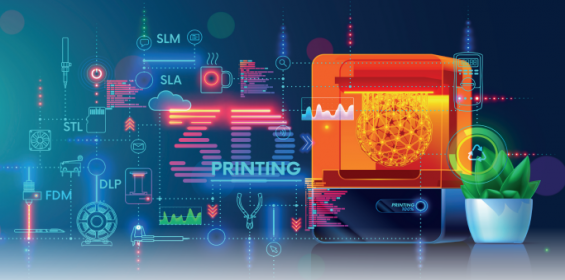For prototyping and testing – 3D printing has the answers
Published: 16 December, 2021
Andy Pye reports on the final Talking Industry session of the year. It covered the burgeoning applications of additive manufacturing (3D printing). Additive manufacturing (AM) uses CAD data or 3D object scanners to deposit material, layer upon layer, in precise geometric shapes
This webinar, Chaired by PWE’s Managing Editor, Aaron Blutstein, focussed on the use of AM by Nidec Control Techniques (CT) of a new drive, not only to prototype the device, eventually to be made in hundreds of thousands, but also to manufacture the jigs and fixtures used in the testing programme. The new model is not in commercial service yet, and so we will cover the story of the new drive and how it was put together in the New Year at: www.talkingindustry.org.
We were joined by Dr Richard Gibson, Product Development Manager at CT and by Chris Althorpe Senior Design Consultant, Kinneir Dufort, the industrial design consultancy which partners with CT for project design services. Gibson has also been with CT for over 20 years, working on component and circuit design and development. More recently, has taken the lead in developing product families from specification to manufacturing. 3D speeds up the process.
Althorpe is another with two decades of experience, this time at Kinnear Dufort. He has used the complete gambit of 3D printing technologies and has worked on many industrial products, as well as medical device design and consumer design.
Our third speaker was James Hunt, Head of Strategy for Additive Manufacturing, at the Advanced Manufacturing Research Centre (AMRC). based at the University of Sheffield. He provided an overview of the 3D printing technologies available. While the other speakers’ experience was weighted towards the polymer side, his is more with metals.
Unusually, the fourth presenter was yet another veteran…myself. I reviewed how additive manufacturing compares with alternative high volume manufacturing processes and how automation of the preprocessing and post-processing phases can make the process more competitive. This enabled our editor Aaron Blutstein to step in and do a great job as session chair.
James Hunt: AM, he said, goes under many different acronyms and names: some are trade names, some more generic. So we have selective laser melting (SLS). direct metal deposition; even inkjet printing is considered to be an additive manufacturing process. But essentially, they all create a functional part or prototype part directly from a digital file using a 3D printer. The material feedstock can be a resin, a polymer powder, polymer filament, metal powder, metal wire, even chocolate, or in some instances concrete!
The key benefits are to do mass customisation, where each part can potentially be unique. And you can introduce really intricate geometries that you can’t manufacture by conventional methods of manufacturing like machining, forging and casting. You can increase functionality, reduce part count, and reduce material waste.
There are broadly at least seven different categories of technologies that ASTM has designated, many of which have been around for about 30 years.
For aerospace applications, there’s a lot of understanding to develop all the materials, data that needs to sit alongside the process to design the parts. That takes time to build up because castings or forgings have been around for centuries and a lot of that information is already there. But there are flight examples from the likes of GE, Boeing, Airbus, they’ve all got metal parts made by AM bits on planes. In the medical sector, there’s are companies in in Ireland in the US that have been making acid tabular cups, for example, or femoral stems for medical for 20 years, making tens of thousands per year. And for these components, it’s actually more cost effective than the conventional methods of manufacture.
Richard Gibson: CT makes industrial variable speed drives. The particular family of interest is in the lower power range for general purpose fans and pumps. An early challenge was to create concepts in a way that people can accept and see what the products are going to look like very early on, so that the larger development budgets can be released, for prototyping, detailed design and then also the scale of manufacture. During the concept phase, the engineers use 3D CAD and they create lots of images.
CAD images are not always easily to visualise for non-engineers, such as the executive board or our finance department, the marketing team, or many prospective customers. So we create models of the end product, before we have made any single parts or tested any parts of the product. And so we worked with Chris [Althorpe] at Kinnear to create a very first off concept model, we had several different designs that we could go through and choose features of each of the designs. And were able to get those 3D printed.
The other area where AM is being used at CT is for jigs and fixtures. “Every drive gets tested at multiple stations throughout the product development, including optical inspection in-circuit testing, and functional testing as well as an end-of-line drive test. We didn’t want to spend time wiring up every terminal then unwire it after we’ve completed the test. So we wanted to prove onto the drive make contact to all of the different terminals. Instead, we wanted to probe the connections with a spring-loaded probe.
The problem with that that we encountered was we had to make sure alignment of the products and the three different sizes of products made sure the alignment of the products with the probes was repeatable. So we developed some of our jigs and fixtures to do that. They need to be lightweight, because part of the product was assembled on the jigs and then lifted into the test machine. And they needed to be usable for every product. We want to use these for millions of different drives.
It’s a new process for us, and we had to make sure we had accommodated all the tolerances that might stack up in the products and in the test fixtures. So we started to 3D print our test fixtures. We used our mechanical engineering team in R&D to refine those jigs.
The full Talking Industry webinar and a longer version of this case study will appear on www.talkingindustry.org
https://www.linkedin.com/company/talking-industry/






 Niall McQuitty, (pictured) architectural director at Stamford-based design firm ARCTICA, has announced he will be discussing best practice in hygienic factory design at a Food and Drink Federation conference entitled Hygiene by Design taking place at the FDF’s London premises on 16 November.
Niall McQuitty, (pictured) architectural director at Stamford-based design firm ARCTICA, has announced he will be discussing best practice in hygienic factory design at a Food and Drink Federation conference entitled Hygiene by Design taking place at the FDF’s London premises on 16 November. Two gas catalytic ovens from HERAEUS NOBLELIGHT have been installed at Life Fitness in Illinois, USA, where they are said to be helping to double production and save costs in the manufacture of high quality gym equipment. The company says they were fitted quickly and easily within a scheduled shut-down period, in the limited floor space available and were operational in less than a month.
Two gas catalytic ovens from HERAEUS NOBLELIGHT have been installed at Life Fitness in Illinois, USA, where they are said to be helping to double production and save costs in the manufacture of high quality gym equipment. The company says they were fitted quickly and easily within a scheduled shut-down period, in the limited floor space available and were operational in less than a month.
